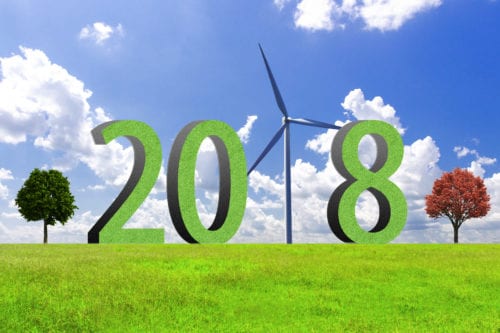In 2018, new energy will make the world a better place

Top Ten Clean Energy Developments of 2018
2018 showed that clean energy is becoming more and more the norm. And we’re not just talking about Bradley Cooper standing in front of a field of wind turbines in the hit movie A Star is Born. In spite of the lack of action from the US federal government, the world is moving forward on clean energy. From India to the Caribbean to businesses and cities in the United States, 2018 was a great year for energy efficiency, electric vehicles, solar and wind energy, and more. Here we list our top ten clean energy developments of the year.
- Carbon-Free Electricity is All the Rage
Xcel Energy committed to supplying its 3.6 million customers with carbon-free electricity by 2050. It is the first major US utility to pledge to go completely carbon-free, but not the only one. The Northern Indiana Public Service Company, Colorado’s Platte River Power Authority, and Michigan’s Consumer’s Energy plan to phase out coal by 2028, 2030, and 2040, respectively. And California, the fifth-biggest economy in the world, is targeting 100 percent renewable electricity by 2045.
- Cities Commit to Net-Zero Carbon Buildings
Mayors from 22 cities around the world committed to having all their buildings be net-zero carbon by 2050 (the same goes for new buildings by 2030). And more than 100 cities around the world now get more than 70 percent of the electricity from renewables. RMI is helping cities reach their goals through net-zero energy (ready) codes, efficiency standards for rentals, residential property assessed clean energy (PACE) implementation, and home energy data.
- Grid-Integrated Buildings Save the Day
As the United States faced its fourth-hottest summer ever, over 200 buildings engaged in demand response actions through real-time energy management software. These grid-integrated buildings not only cut electricity use at critical moments, preventing blackouts, but also provided real savings for the building owners.
- We Learned We Can Even Abate Hard-to-Abate Sectors
The Energy Transitions Committee released a report, Mission Possible: Reaching net-zero carbon emissions from harder-to-abate sectors by mid-century, determining that some of the most polluting, hard-to-abate sectors, such as cement, steel, plastics, trucking, shipping, and aviation, can reach net-zero carbon emissions by 2050.
- Islands Are Getting Serious About Energy Resiliency
Island utilities, governments, and communities are considering how to best incorporate resilience into both short-term recovery efforts and long-term planning in the energy sector. For example, Caribbean island utilities are taking steps toward their first large-scale energy storage projects and Puerto Rico is getting serious on innovative microgrids through first-of-a-kind regulations (with Hawaii’s legislature calling on its own public utilities commission to look to Puerto Rico to inform its microgrid tariffs).
- More Oil and Gas Companies Pledge to Reduce Methane Emissions
In late 2017, a group of eight international oil and gas companies—BP, Eni, ExxonMobil, Repsol, Shell, Statoil, Total, and Wintershall—signed on to a set of guiding principles aimed at reducing methane emissions from the oil and gas industry. In 2018, interest grew and Russia’s Gazprom—which holds the world’s largest natural gas reserves—and Qatar Petroleum—which drills in the largest single non-associated gas reservoir in the world—also signed on to the commitment.
- Corporations Purchase Record Number of Renewables
Corporate renewable energy procurement set a single-year record for new capacity of announced wind and solar deals in 2018, reaching 6.43 gigawatts. Facebook, AT&T, Walmart, ExxonMobil, and Microsoft led the clean energy acceleration with the top five highest volumes in deals. Facebook led the year with the highest capacity, signing several deals totaling 1,849.5 megawatts, while also breaking all cumulative annual procurement records for a single buyer since deals have been tracked.
- India Moves Ahead on Clean Mobility
India, with some of the most polluted cities in the world, is getting serious about transforming its mobility sector. In September, the government of India hosted a global mobility summit, and in October, Pune was selected as the first Lighthouse City for an urban mobility lab, a platform that supports a replicable process to transform the way goods and people move in Indian cities by identifying, integrating, implementing, and scaling cost-effective and clean pilot projects.
- Zero-Energy Homes Become Cost-Effective
Zero-energy homes—efficient homes that produce or procure as much renewable energy as they consume over the course of a year—have quietly passed cost thresholds that make them not only good for the environment but also cost-effective. Meanwhile, federal mortgage lender Freddie Mac launched new services to help low-income families make their homes more energy efficient.
- China’s Electric Vehicle Market Booms
In 2018, electric vehicle sales in China topped 1 million. And the market is only expected to grow as a new government regulation requires all major manufacturers operating in China to produce a minimum number of electric, plug-in hybrid, and fuel-cell cars, starting in 2019. China is also a leader in electric buses, and the city of Shenzhen is the first city to electrify 100 percent (more than 16,000) of its buses.